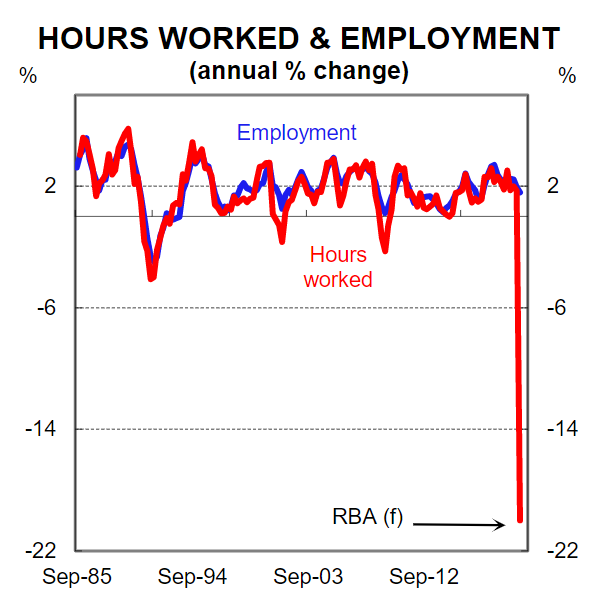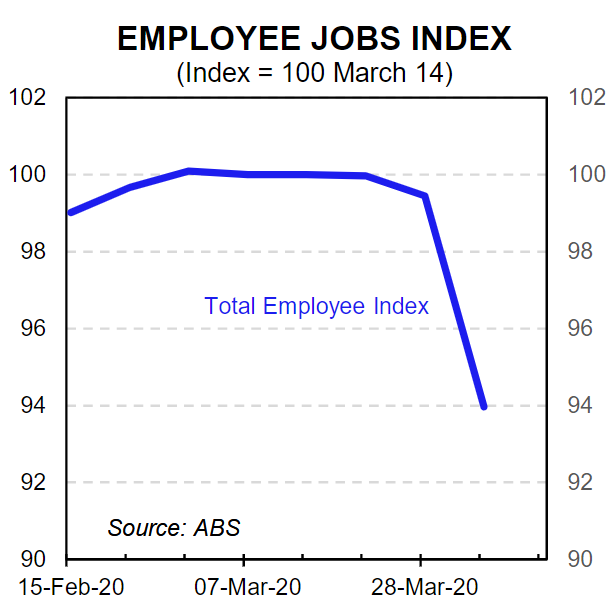By Gareth Aird, senior economist at CBA
Key Points:
- The true deterioration in the Australian labour market as a result of the COVID‑19 pandemic is not expected to be adequately reflected in the reported change in the level of employment or the unemployment rate.
- We do not expect to see a double‑digit unemployment rate because a significant proportion of workers who have lost their job will not be ‘actively looking for work’.
- All workers who are receiving JobKeeper will be considered employed by the ABS ‑ even if they are working zero hours.
- The change in the total number of hours worked will most accurately capture the impact of COVID‑19 on the Australian labour market.
Introduction:
One inevitable consequence of the policy decision to shut down entire parts of the economy to limit the spread of COVID-19 is large scale job losses. At face value an economic shock that results in a plunge in GDP of the magnitude that most forecasters are expecting, including the RBA and IMF, should comfortably result in double digit unemployment. But we have good reason to believe that the unemployment rate will peak at a lower level than intuition would suggest.
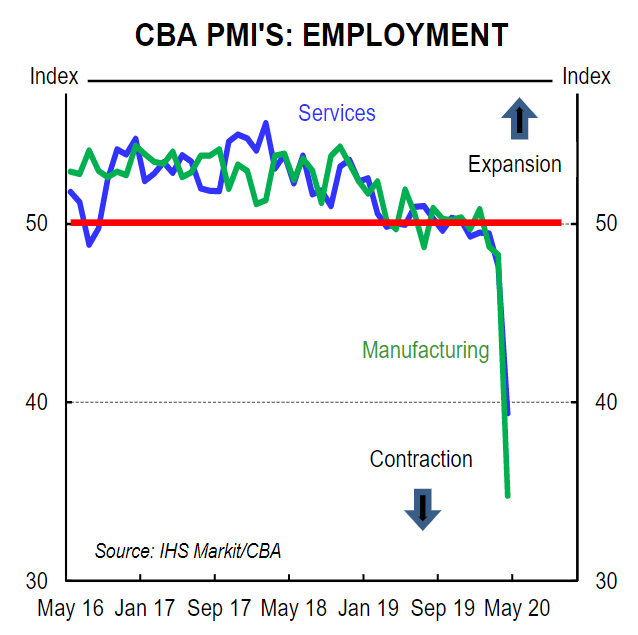
Basically there are a few quirks in the official definitions of employed and unemployed as used by the ABS that mean two things: (i) the recorded level of employment will be a lot higher than the number of people who are actually working; and (ii) the change in the number of people considered unemployed will be a lot lower than the number of people who lose their job due to the enforced shutdown. This note explains why.
JobKeeper and the definition of employed
Economics 101 means that employers pay their employees to work (i.e. payment to produce goods and services). But JobKeeper will mean employees will be paid a salary from the government, via their employer, even if they are not working. This will have a profound impact on labour market statistics because of how the ABS defines a person who is employed. Generally the ABS considers a person to be employed if they have worked one hour or more for some form of payment. But there are a few exceptions to this and JobKeeper will be one of them.
More specifically, the ABS has determined that people who are paid through the JobKeeper scheme will be classified as employed, regardless of the hours they work (e.g. even if they are stood down and do not work). Historically to be considered employed is to receive payment for work. But in essence the accounting of JobKeeper means to be employed is simply to be paid.
There will be a very large number of people receiving JobKeeper who will not be turning up to work over the next few months because their employer is shut (i.e. a lot of employees will be working zero hours a week). But despite not working they will be considered employed in the ABS monthly labour force survey.
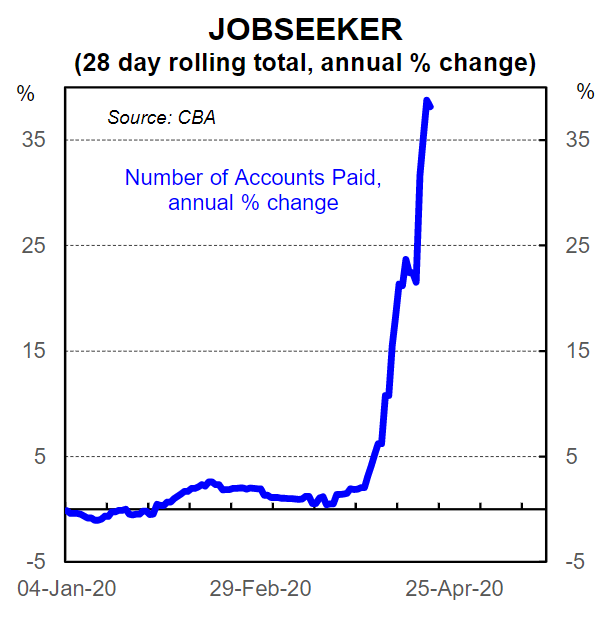
The definition of unemployed
According to the ABS, to be classified as unemployed someone must: (i) not be employed during the reference week; and (ii) have actively looked for work and be available for work in the reference week.
They key to us is ‘actively looked for work’. The ABS defines ‘actively looked for work’ to mean that someone has done at least one of the follow: written, telephoned or applied to an employer for work; had an interview with an employer for work; answered an advertisement for a job; checked or registered with an employment agency; taken steps to purchase or start your own business; advertised or tendered for work; and contacted friends or relatives in order to obtain work.
We expect that a large number of people will have lost their job, but will not be actively looking for work while out of work. These people are still eligible to receive JobSeeker despite not looking for work. Indeed the ABS states that, “people who receive the JobSeeker or other similar government payments are not necessarily classified as unemployed”. And they also note that, “recent changes to the JobSeeker program as result of COVID-19 mean that recipients do not have to meet the usual mutual obligation requirements (such as looking for work).
”Currently for a lot of people who have just been displaced there is no incentive to look for a job because there are no job openings in their area of expertise. If someone lost their job, for example, as a bartender there is no point looking for another job as a bartender while pubs and hotels are shut. The increase in JobSeeker will also serve as a disincentive for people to look for work, particularly given the lack of jobs on offer. The JobSeeker payment has been doubled from previously $A550 a fortnight to $A1,100. For many people that lose their job it will simply make more sense to receive JobSeeker and wait for the shutdown to end rather than ‘actively looking for work’ while large chunks of the economy remain shut. In which case, despite a person losing their job and receiving JobSeeker they will not be considered unemployed. This will have a profound impact on the level at which the unemployment rate peaks.
What do we expect?
Our forecast is for total employment to fall by around ~700k over the June quarter. But we believe that there could be as many as one million people who will be classified as employed, but won’t be working any hours. These people will receive JobKeeper but will not be producing any output. That is why total hours worked is expected to plunge and will look vastly different to the decline in employment. The RBA, for example, estimate that total hours worked will decline by around 20% over Q2 20.
We also believe that the fall in the level of employment will be bigger than the rise in unemployment because we expect participation in the workforce to dip. There will be a lot of people who were previously working, lose their job and receive the JobSeeker payment, but will not classified as unemployed. This will be captured in the participation rate. Our forecast is for the participation to drop by 1.5ppts to 64.5% which would see the unemployment rate rise to ~9% on job losses of ~700k. These forecasts imply that ~250k people will lose their job but not be considered unemployed by the ABS because they will not have actively looked for work. It would not surprise us if that figure ends up being a lot higher.
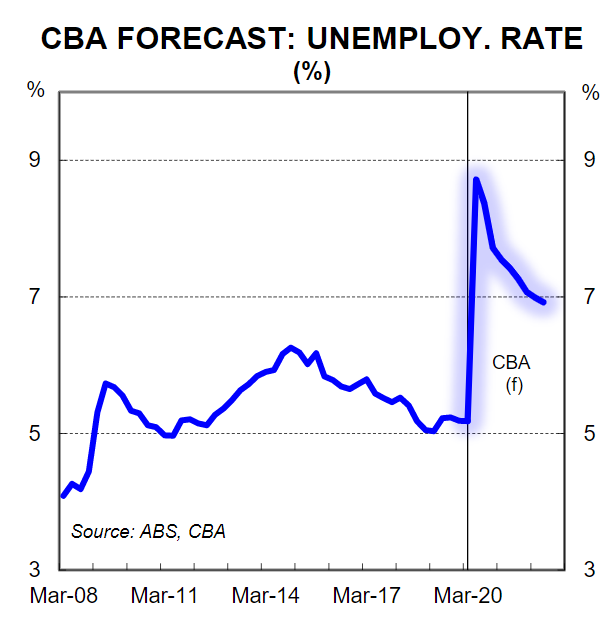
What else to look for?
It is clear that the change in the level of employment and unemployment rate will not fully or accurately reflect the true deterioration in the Australian labour market as a result of the COVID-19 pandemic. We recommend focusing on a range of other indicators that relate to the labour market to more fully understand the dynamics at play over coming months. These indicators include, hours worked, the participation rate, the new weekly ABS payrolls series, the number of people receiving JobSeeker and the employment component of the CBA PMIs. We will be reporting on all of these measures.
